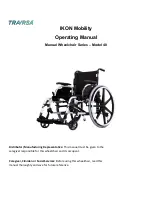
Issue No: SQCA1 2010
18
STEP 4: Insert and engage locking pins.
WARNING!
Ensure locking pins are fully engaged before use. Failure to secure anti
tipper, could result in personal injury or property damage.
WARNING!
DO NOT replace during use.
4.9.3. ADJUSTING ANTI-TIPPER CASTOR HEIGHT
Follow the steps below to adjust the anti-tipper castor height;
STEP 1: Remove nut cap.
STEP 2: Remove nut with a 19mm socket
spanner.
STEP 3: Make a note of the position of spacers
above and below castor housing.
STEP 4: Remove castor assembly from castor pot.
STEP 5: Re-arrange spacers to the desired height.
Extra spacers below the castor housing will lower
the castor. Extra spacers above the castor
housing will raise the castor wheel,
see image 21
.
STEP 6: Replace castor stem bolt into castor
housing.
STEP 7: Place remaining spacers on top of castor
stem bolt.
STEP 8: Replace the nut onto to the stem bolt and
tighten so the castor can move freely but without
any up or down movement.
STEP 9: Replace the nut cap.
WARNING!
DO NOT over tighten nut. Over
tightening the nut can damage the bearings and
lock the rotation of the castor wheel.
4.10.
SEAT POSITION
The following section contains important information regarding the front and rear seat
height adjustment.
WARNING!
DO NOT attempt to adjust the seat height when seated in the wheelchair.
WARNING!
Ensure all locking pins are correctly located and securely fastened before
using the wheelchair.
4.10.1. ADJUSTING REAR SEAT HEIGHT
Follow the steps below to adjust the REAR seat height;
STEP 1: Release the 2 handles which secure the side guards, with just 1 or 2 turns.
STEP 2: Remove the 2 locking pins from back of chair.
STEP 3: Use the brace on the backrest to raise or lower the seat height to the desired
height.
STEP 4: Align holes, fully insert the 2 locking pins and secure.
STEP 5: Secure the handles on the side guards.
Image 21: Anti-tipper spacers
Above spacers
Below spacers





































